
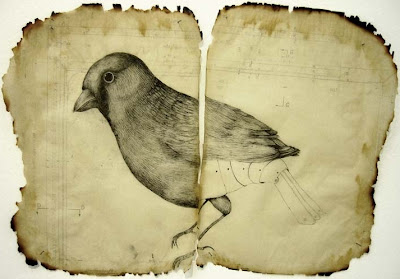
Illustrations, etchings, installations and videos © Eric Ailcane.

Jupiter with man's severed head standing over Sagittarius and Pisces

Mars with helmet, lance, shield standing over Aries and Scorpio

Mercury, carrying pair of green snakes and sack
of money, standing over Virgo and Gemini
of money, standing over Virgo and Gemini

Tierkreiszeichenmann - man with of signs of the
zodiac on body parts that they rule (Zodiac Man)
zodiac on body parts that they rule (Zodiac Man)
This 1429 'Medizinisch-Astrologisches Hausbuch' (Medical Astrology Housebook) from Nuremburg - "links and systematizes medical and astrological knowledge to create a kind of everyday handbook for medical treatments, especially bloodletting, to be administered by laymen at home. It is based on the medieval idea of the influence of the planets on the health and character of human beings. The mixing of astrology and saints’ days in the calendar is evidence that medieval man saw the heavens as another revelation of God; thus astrology and faith are not at odds. This specimen - a “rich man’s” version, [was] probably commissioned by a wealthy patron."
This is likely a source document for a medical astrology manuscript from a previous post (Munich, 1487). The above treatise is one of quite a few digitized manuscripts available from 'The Cooperative Digital Resources Initiative of the American Theological Library Association and Association of Theological Schools [..] - repository of digital resources contributed by member libraries.'


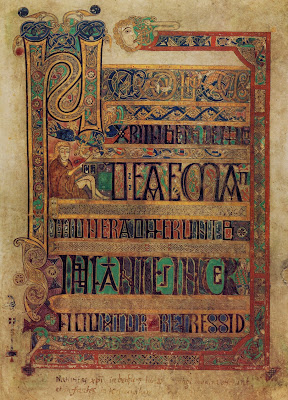
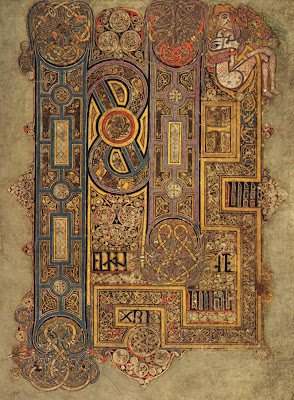

The Book of Kells from the beginning of the 9th century is possibly the most famous illuminated manuscript in the world. I've had a few people ask why I haven't made a post about it. The simple answer is that there are very few page images available online ... or so I thought. Dublin's Trinity College is no doubt protective of their half million visitors per year.
So it was interesting to find a sizeable stash of more than 20 page images and details at Visipix the other day. Their images are large but they are not quite your high falutin' university grade scans. Still, they give an indication of the extraordinary beauty in what was essentially a biblical book of gospels.
- Just found: wikimedia have about 30 pages; also some here.
- The whole manuscript is available as a dvd-rom for a reasonable 2-figure price.
- The whole manuscript is also available as a high quality edition from Faksimile Verlag in Switzerland, but it will set you back $18,000.

'Tel maitre, tel valet'
{'Like master, like servant'}
{'Like master, like servant'}
"From the late 1820's to the late 1830's, [Edme-Jean Pigal] produced numerous lithographs caricaturing contemporary customs and social types, in which he ridiculed the hypocrisy of the bourgeoisie and the vulgarity of the lower classes. His favorite characters were the street urchins of Paris, servants, coachmen and doormen, and lecherous old men."[source]
The wonderful database of The Fine Arts Museums of San Francisco has 14 Pigal prints available. There are very few other Pigal illustrations around that I can find - mostly just poster shops. The image above is spliced from Zoomify screencaps and the background has been cleaned up significantly.

'Duchy of Uppland - Coat of Arms'
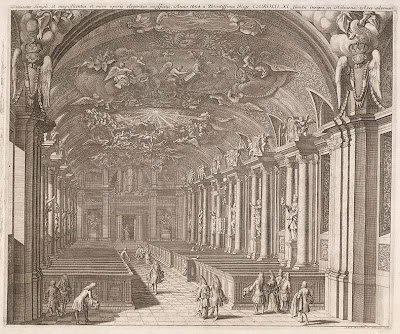
'A reproduction of the magnificently delightful and at
great cost decorated palace church in 1694 by His Almighty
Highness, the King Karl XII (interior facing west)'
great cost decorated palace church in 1694 by His Almighty
Highness, the King Karl XII (interior facing west)'

'Reproduction of the famous Prince Birger Jarl,
regent and father of the kings Valdemar and Magnus'
regent and father of the kings Valdemar and Magnus'

'View of the most enchanting Kungsträdgården
in Stockholm as seen from the north'
in Stockholm as seen from the north'
"The literary, scientific and cultural magnum opus, Suecia antiqua et hodierna is a work of distinction from Sweden's period as a great power." and appears to be online in its entirety at the Royal National Library of Sweden.
There is a convoluted essay that describes in detail the convoluted evolution and printing/engraving history of 'Suecia antiqua et hodierna', which I think was completed in about 1667. There are myriad engravings available.





These frog electrophysiology experiments are part of a 60 year compendium or Proceedings from 'De Bononiensi Scientiarum et Artium Instituto Atque Academia Commentarii'- from memory there are numerous other scientific engravings, also mostly to do with electrophysiology (dissected species nerve networks and the like). The work, produced between 1631 and 1691, was edited by Giovanni Bacialli and is online at the University of Bologna (bottom left link for page images).
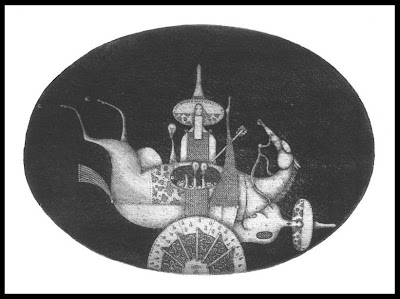


These 3 etchings are © the estate of Russian graphic artist, Aleksandr Aksinin (1949-1985), killed in a plane crash on his way to an exhibition in Tallin. Galleries: one, two, three, four. [Toronto Slavic Quarterly article]

Cornelio Malvasia made his 17th century astronomical observations from the luxury of his own personal observatory near Modena in Italy. This moon map is from the last online page of his 1662 work 'Ephemerides Novissimae Motum Coelestium' at Bologna University [bottom left link for page images]. (previous related moon map posts: a, b, c; astronomy)
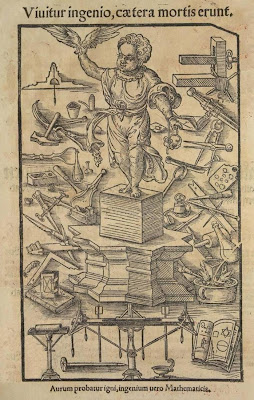
This veritable mathematical study sanctuary (or torture chamber) for a child appears in Walter Hermann Ryff's 'Der Architectür fürnembsten, notwendigsten, angehorigen mathematischen vnd mechanischen Künst' from 1558 -- among the 30+ digitized books in 'Bibliotheca Perspectivae' at the Institute and Museum of the History of Science in Florence. It wasn't until after I nabbed it that I realised that it was watermarked, which I've removed.

Bidding has just finished for this 1486 illustrated first hand coloured edition of 'Supplementum Chronicarum' by the Augustinian Monk, Jacobus Philippus Bergomensis. This was the forerunner/source/influencing chronicle of the world for the famed Nuremberg Chronicle by Hartmann Schedel of 1493. [Sicily's regional library have a few full page images from 'Supplementarum Chronicarum'].
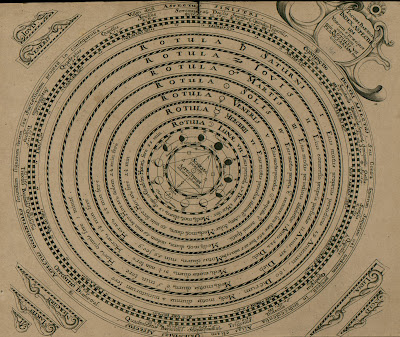

Jakob Bartsch was son-in-law of and assistant to Johannes Kepler. This geocentric rendition of the Ptolemaic universe and lunar eclipse chart come from an 8-page supplement called 'Planisphaerii Stellati' from 1661 (I'm assuming this was a supplement to the longer 'Planisphaerii Stellatum' from the same year). 'Planisphaerii Stellati' is available from L'Université Louis Pasteur in Strasbourg.

'Jupiter assistant au combat des rats et des grenouilles'
This woodcut scene from the war of the rats and the frogs ('Batrachomyomachia'), attributed to Homer, is the single illustration available at BNF from a 1540 french translation of the comic poem from the original greek.

This is the single illustration/titlepage from an anonymous 17th century hermetic alchemy manuscript called 'Explicatio Figurae Hermeticae a Khunrahdo Designatae' at the Schoenberg Center. (presumably referring to Khunrath)
Some other essentially random things...
- Pink Tentacle have a great entry about the mythical Kappa from Japanese folklore - a sort of childlike (and child luring) sea creature. I've posted a few of these images from time to time previously but without knowing the background.
- 'Forty Centuries of Ink' by David N. Carvalho.
- New York Review of Books has a 50% sale until March 11. (via fade theory)
- 'Your Old Books' - "This guide addresses some frequently asked questions about rare and older books and their values." (Also: Bookride, a review and pricing blog of collectible books)
- Great Caricatures (commercial site) via hanuman.
- A large selection of Russian childrens' book illustrations (contemporary).
- Dorothy Simpson Krause: book artist..and much more besides - click around, there's a lot in here.



No comments:
Post a Comment